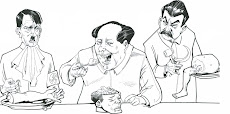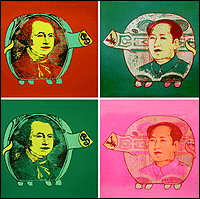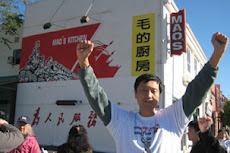China's Business Climate Worsens for U.S. Firms 美国在中国的公司的困境
 China is Not a Free Country 中国只是一个“党奴朝” 陈凯博客: www.kaichenblog.blogspot.com 陈凯一语: Kai Chen's Words: 中国的经济泡沫很快就会爆裂,因为中共党朝“反自由”、“反竞争”、“反真实”的性质。 不印票子,国营企业就会破产。 不压低工资,出口就会减缩。 普通人建立不了自己的信用,也因此与银行信贷无缘。 这样通货膨胀就是必然产物。 中国经济崩盘的日子就在眼前。 The huge Chinese economic bubble will burst soon, because the nature of the Chinese Party-Dynasty: It is anti-freedom, anti-competition, anti-truth/reality. Not to print money, the state-owned companies will collapse. Not to suppress domestic income, China's export machine will slow down and stop. Ordinary people in China have no way to establish credit and no way to borrow money from China's banks. Inflation is a necessary result. China's economic collapse and the end of Chinese Party-State are very near. Don't Bank on China 'Rebalancing' 中国没有挽救自己经济的机制 There are deeply rooted reasons—from banking habits to government policy—why Chinese are unlikely to increase consumption anytime soon. . "Beijing could solve these problems, slowly, if leaders wanted to. Odds are that they don't, though. The current pro-export banking bias is not an accident. It represents Beijing's deliberate choice to maintain a degree of control over the economy via political allocation of capital. The 2009 credit stimulus shows that instinct is still alive and well." By JOSEPH STERNBERG,Wall Street Journal Chinese President Hu Jintao is in Washington this week, and economic affairs are sure to feature prominently. Inevitably, that will mean talk of "rebalancing," the notion that Americans need to consume less and Chinese need to consume more. This is typically presented as a question of aggregate American and Chinese levels of investment, household savings and consumption, plus the exchange rate. But the problem with Chinese consumption runs much deeper, a fact that should inform the discussion on both sides. To see how and why this is, look at banks, which affect so much of the rest of the economy. To start, China lacks the infrastructure of modern consumer finance, and is years—possibly decades—away from building it to the standards of the developed world. Outstanding consumer credit stands at about 13% of GDP, according to a 2009 study from McKinsey & Company, compared to 48% in Malaysia and 70% in South Korea. Banks face significant structural and regulatory barriers to offering more consumer-finance products. One is the lack of national consumer credit ratings that would give banks greater confidence in their ability to measure credit risks. Another is that loan officers and managers still work from a mindset focused heavily on business lending. Meanwhile, Beijing has lost a decade or more during which it could have allowed foreign banks to start developing a consumer-finance market. Thus Chinese banks have faced few competitive pressures to serve lower-income consumer borrowers themselves, so they haven't. Only in November did regulators allow a foreign company into this brand-new field. Dutch PPF Group will offer in-store financing for durable-goods purchases—the kind of installment plan that made its appearance in America 160 years ago. More interesting is the supply side of the consumption equation. Rebalancing is not a matter of Chinese export factories losing a foreign customer and gaining a domestic one, Patrick Chovanec of Tsinghua University observes. Export factories are part of global supply chains in which someone else does the product development, logistics, marketing and retailing. Chinese export factories aren't equipped to do those things on their own. Rebalancing would cause them to lose foreign customers and go out of business, allowing entrepreneurs who are oriented toward domestic consumption to buy the assets. China needs to reallocate capital and labor on a massive scale to orient itself toward producing goods and services that Chinese consumers want to consume. This will require major banking changes, especially improving access to credit for the small and medium-sized enterprises that make a modern consumption-driven economy tick. Both regulation and habit will get in the way. The regulation involves interest rates: Government manages both deposit and lending rates in a way that guarantees banks a wide spread. This was intended to help banks earn themselves out of an earlier generation of nonperforming loans at the expense of households, which earn lower rates on savings deposits. And the policy could prove especially necessary if 2009's credit binge results in huge piles of bad debts. But the policy hurts consumption by depressing household earnings on savings. It also depresses bank lending to small enterprises by discouraging bank risk-taking. Instead of taking a chance that some of their guaranteed profit margin might be eaten up by a nonperforming loan to a small start-up, banks can reap the entire spread by lending to larger state-owned enterprises whose debts the government implicitly or explicitly guarantees. A related banking habit is insistence on physical collateral, often real estate, a stricture that favors asset-heavy state-owned companies and exporting manufacturers. Any other kind of business lending is more challenging, as it involves training each loan officer and his manager to evaluate a small firm's business plan and projections to reach a judgment on creditworthiness. And without clear laws in place for when uncollateralized loans go bad, banks will continue to prefer the comfort of having assets to seize if worse comes to worst. Beijing could solve these problems, slowly, if leaders wanted to. Odds are that they don't, though. The current pro-export banking bias is not an accident. It represents Beijing's deliberate choice to maintain a degree of control over the economy via political allocation of capital. The 2009 credit stimulus shows that instinct is still alive and well. All this suggests two implications for this week's Washington powwow. For one, President Obama needs to be more realistic about the prospects of China rebalancing any time soon. It's a mistake for him to rely on a rapid rise in Chinese consumption to fill a global economic gap left by the failure of his policies to stimulate the U.S. economy. As for Mr. Hu, a bit of humility is in order. China's investment-driven growth has paid off so far but may already be witnessing declining marginal returns. McKinsey estimates that China now needs to invest $4.90 to produce each dollar of GDP growth, up from $3.30 in the early 1990s. Shifting to a new model will require changes at every level, right down to the bank branch. That's hard to do when you're preoccupied asserting economic might you may not have. Mr. Sternberg is an editorial page writer for the Wall Street Journal Asia. --------------------------------------------------------------------------------------
| |||||||


































No comments:
Post a Comment